When calming a stressed or anxious dog, the best place to touch them depends on their individual temperament and what they find most relaxing. Understanding these preferences is key to providing the comfort they need. Here are some general guidelines to help you determine the best spots to touch your dog for calming effects.

Generally Calming Areas
- The Chest or Side: Many dogs find stroking on the chest or side, near the front legs, to be very calming. This area is non-threatening and can have a soothing, massaging effect. Gently place your hand on the chest or side and use slow, rhythmic strokes to help your dog relax.
- The Back: Gently stroking down the back from the shoulders to the base of the tail can be soothing for some dogs. It’s important to avoid applying too much pressure as this can cause discomfort. Instead, use light, gentle strokes to create a calming effect.
- The Neck (Be Cautious): Some dogs enjoy gentle stroking on the sides of the neck, but it’s important to be cautious as this can be a sensitive area for many dogs. Avoid touching the top of the head and muzzle, as these areas can make some dogs feel threatened. Instead, focus on the sides of the neck with soft, gentle touches.
Additional Techniques
- Ear Rubs (Use Caution): While many dogs love ear rubs, some find them overstimulating. Pay close attention to your dog’s body language to ensure they are enjoying the ear rubs. If your dog seems to relax and lean into the touch, continue with gentle ear rubs. If they pull away or show signs of discomfort, stop and try a different technique.
- Massage: Gently applying massage techniques can be very calming for some dogs. Focus on long, stroking motions rather than deep pressure. This can help relax their muscles and provide a sense of comfort. Start with light touches and gradually increase pressure if your dog seems to enjoy it.
Important Considerations
- Read Your Dog’s Body Language: The most important thing is to pay attention to your dog’s signals. If they tense up, lean away, or whine when you touch a certain area, stop immediately and try a different spot. Understanding your dog’s body language is crucial to providing effective comfort.
- Start Slow and Gentle: Always begin with gentle strokes and avoid grabbing or startling your dog. Sudden movements can increase anxiety, so take your time and allow your dog to get used to your touch.
- Maintain a Calm Demeanor: Keep a calm and soothing voice and demeanor while petting your dog. Dogs can sense your emotions, so staying calm will help them feel more secure and relaxed.
- Respect Their Boundaries: Not all dogs enjoy being touched everywhere. If your dog seems uncomfortable, give them space. Respect their boundaries and find alternative ways to provide comfort if necessary.
Alternative Calming Methods
- Offer a Safe Space: Provide your dog with a familiar crate, bed, or quiet corner where they can feel secure. Having a designated safe space can help reduce their anxiety and provide a sense of security.
- Distraction: Sometimes, distracting your dog with a toy or favorite activity can take their mind off their anxiety. Engage them in play or provide a puzzle toy to keep them occupied.
- Desensitization: If there’s a specific trigger for your dog’s anxiety, gradually expose them to the trigger in a controlled way while providing positive reinforcement. This can help them build a tolerance and reduce their anxiety over time.
By trying different techniques and observing your dog’s response, you can find the most effective way to calm them down. Consulting with a veterinarian or animal behaviorist can also be helpful, especially if your dog has severe anxiety issues. Understanding and respecting your dog’s needs will go a long way in helping them feel safe and relaxed.
